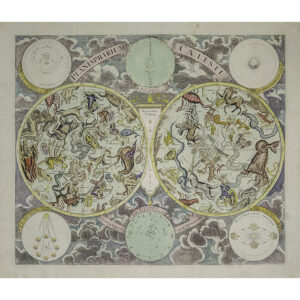Description
There are three illustrations of the boat: The Model Boat, the boat as seen on the Delaware River in 1787 documented at a speed of 7 miles per hour, and an illustration labeled with numbers and letters corresponding to descriptions of various machinery and people on board. The following are identified: John Fitch, Robert Fulton, R. R. Livingston, Esq, Lad Hutchings, the boiler, maine [sic.] pipe, valve box, smoke pipe, and other parts.
A dedication appears in the bottom portion of the print: “The world is indebted for the original idea and to the mechanical genius of John Fitch, of East Windsor, Conn. And to the perseverance and indefatigable attention to the use of Steam of Robert Fulton Esq. Pa. The wealth & exalted character of Robert R. Livingston Esq. Chancellor of the State of New York.”
Text in the right margin provides an account of the story regarding John Fitch’s steam boat, relevant history, and a description of the boat. To the left is a biography for Fitch, in addition to signed testimonials by acquaintances attesting to their friendship and to having witnessed his boat sailing.
An identical example of the map, in the collection of the New York Public Library, Rose Fund donation, is described in the context of the history of Collect Pond, as follows:
Located just north of the present City Hall, the natural spring-fed Collect Pond was the main source of fresh water for New York City until the Croton Aqueduct system was opened. The African American burial ground was adjacent to Collect Pond, along with the city armory and a tannery. Gunpowder, animal slaughter, and burial sites must not have made for a pleasant scene. A canal was built to drain the now fetid pond, and that canal later was paved over to form Canal Street. On early maps of the city, such as the Montresor map of 1767, one can see the low marshy ground, which demanded drainage. John Fitch is said to have tested his steam engine in Collect Pond in 1793, and there are numerous commemorative maps attesting to his experiments, which predated the work of Robert Fulton.
Condition: Generally fine, with only slight toning overall, folds as issued. Possible extracted from a book or other publication.
Reference:
“Collect Pond, Manhattan.” New York Public Library: American Shores, Maps of the Mid Atlantic Region to 1850. 2002. http://www.nypl.org/research/midatlantic/geo_collect.html









